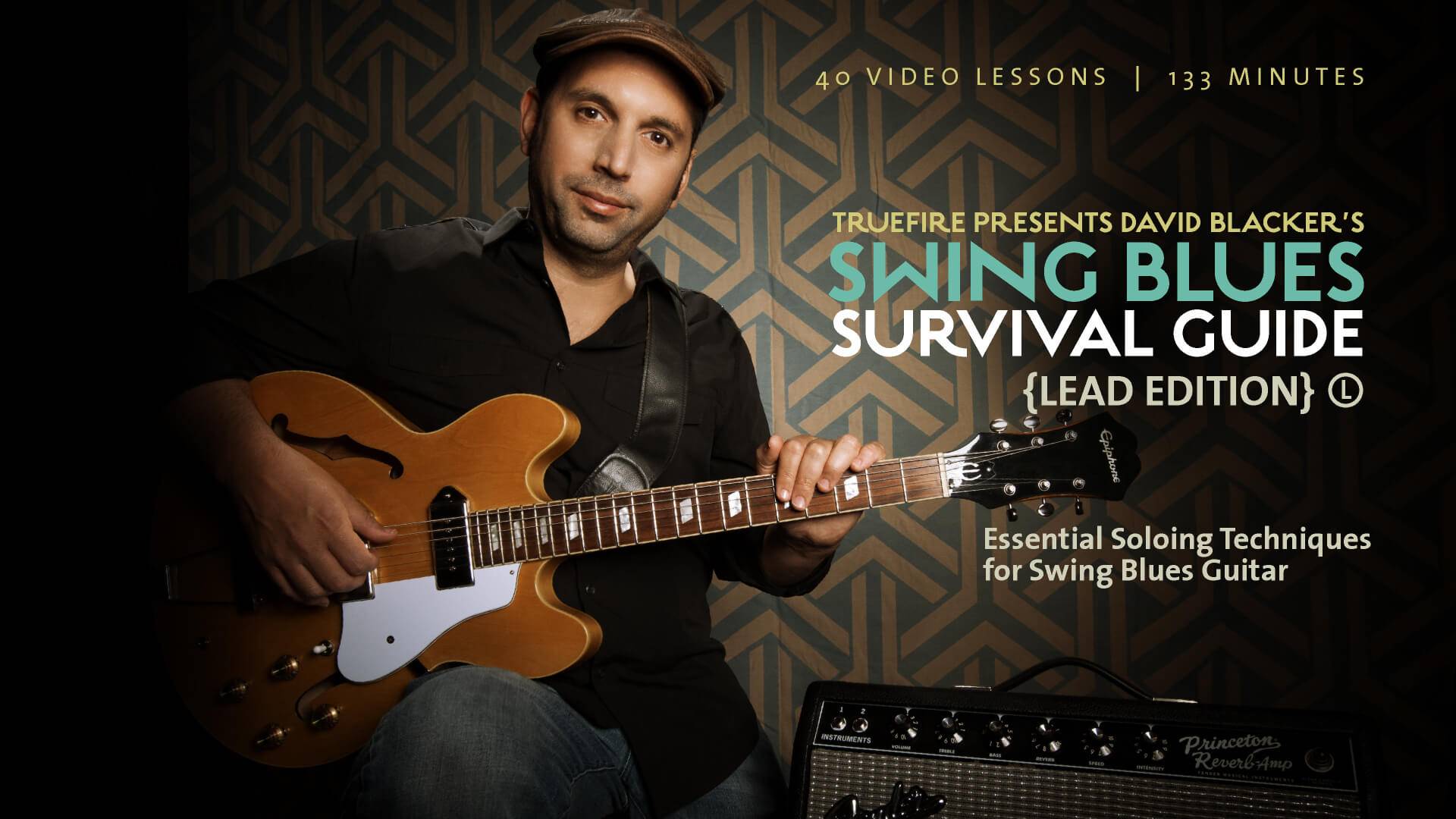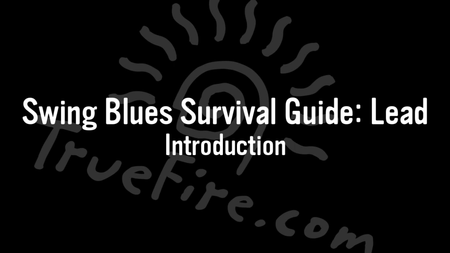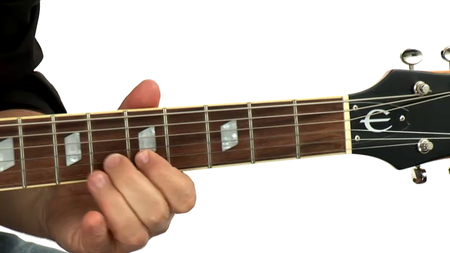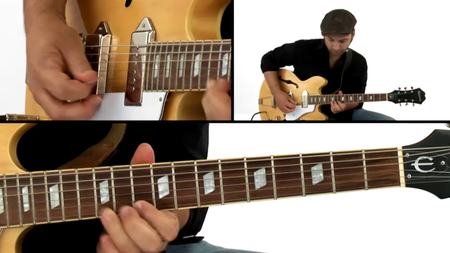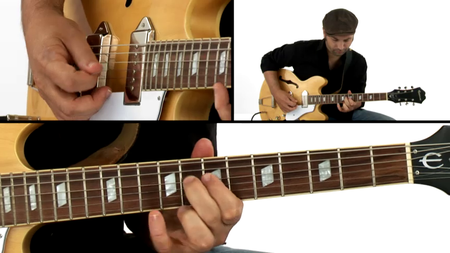TrueFire - Swing Blues Survival Guide Lead Edition with David Blacker (2016)
(.MP4) in an interactive shell | English | PDF tabs + MP3 jam tracks | 864 x 486 | AVC ~965 kbps | 29.970 fps
AAC 128 Kbps 48.0 KHz | 2 channels | 133 minutes | 1.17 GB
Genre: eLearning Video / Guitar lesson
(.MP4) in an interactive shell | English | PDF tabs + MP3 jam tracks | 864 x 486 | AVC ~965 kbps | 29.970 fps
AAC 128 Kbps 48.0 KHz | 2 channels | 133 minutes | 1.17 GB
Genre: eLearning Video / Guitar lesson
Swing Blues encompasses a variety of genres from the jazzy influenced Jump and West Coast styles to the Western Swing and Rockabilly styles of the 40’s, 50s and 60’s. Guitarists like T-Bone walker, Bill Jennings, Tiny Grimes, Duke Robillard, Hollywood Fats and Charlie Christian are widely acknowledged for establishing the role of the guitar in this exciting and still very popular musical genre.David Blacker’s Lead Edition of the Swing Blues Survival Guide guides you through all of the essential concepts and techniques you’ll need to play solid lead guitar across virtually the entire Swing Blues songbook.
”In the Lead edition of my Swing Blues Survival Guide, we’re going to look at approaches like note targeting, phrasing, transposing phrases to unlock different areas of the fretboard, playing off of chords, playing through transitions, and working with chromaticism. We’ll then apply those techniques across 12 soloing Performance Studies covering the stylistic approaches of many of the great swing blues players. “
David organized the course into two sections. In the first section, you’ll learn the 5 key concepts that form the basis for playing swing blues lead guitar: Note Targeting 101, Transpose It Down, Transpose It Up, Chromaticism and Pull-Off Backslides.
In the second section, you’ll play your way through 12 Performance Studies applying all of the essential concepts and techniques that you learned in the first section. David demonstrates all of the Performance Studies over rhythm tracks and then breaks them down by stepping you through the key concepts and techniques employed in the solo.
Billy Boy (2 Solos) - ”In the first solo of Billy Boy, we're going to look at some great Bill Jennings ideas. Some key take-aways are a great transition lick over the 7th & 8th measures, and a classic II-V-I turnaround. In the second solo ofBilly Boy, we're going to move up the neck and look at some great Bill Jennings ideas that play off of key chord shapes. We'll look at another great 7th & 8th measure transition riff and a II-V-I turnaround.”
Swing It On Over (1 Solo) - ”In Swing It On Over, we'll look at some ideas inspired by the great solo on the Hank Williams song Move It On Over. It's in the key of E, and incorporates some great major/minor based pentatonic fingerings and western swing style phrasing. The key take-aways from this piece are the movement between minor & major pentatonic fingerings and rolling hammer-ons. This Performance Study also employs a lot of key note targeting and playing through the chord changes.”
Shades of Duke (2 Solos) - ”Shades of the Duke is a look at two solos in the style of Duke Robillard. Duke is a master swing blues stylist, and someone you've got to spend a minute studying to get a solid handle on. I highly recommend all his recordings, but the album Swing is a great starting place. It features a ton of great swing blues language and phrasing. The two solos are in the key of Bb, a very common swing blues key, and are meant to be played together as one long solo. They incorporate some key melody based riffs, transitional elements, II-V-I turnarounds, and ideas in multiple octaves and positions on the neck.”
Elementary, Mr. Watson (1 Solo) - ”This Performance Study is a take on a Texas style shuffle in the style of Junior Watson. Junior Watson is a great west coast blues player. I highly recommend the William Clarke album Double Dealin’, where Junior's playing really shines within a great harp/guitar jump sound. He spans of a lot of different genres, from swing & bebop to classic blues and jump. This shuffle highlights a few of his unique phrasing ideas as applied to a shuffle in Bb.”
Jumpin' In The Boneyard (2 Solos) - ”T-Bone Walker is a central figure in the world of swing blues guitar. His playing has influenced tons of players from B.B. King to Stevie Ray Vaughan to Buddy Guy to Duke Robillard and many more. His style is really unique and characteristic, and getting the feel of his approach to phrasing will really help you progress in this style. I highly recommend the Black & White Recordings put out by Capitol Records. These two pieces are in the key of C, and are based off the tune T-Bone Jumps Again. String them together to make a two chorus extended solo.”
From Tiny to Junior (2 Solos) - ”These Performance Studies originated from a Junior Watson solo that I came across in a YouTube video. However, I found out later that the 2nd half of the solo was quoting a number of lines from a Tiny Grimes solo in a song called Call of the Wild off his recordings with The Rocking Highlanders, ergo the name From Tiny to Junior. It's got a lot of great west coast/jump language in it. I recommend taking it slow or learning it at half tempo as it's got a lot happening.”
Hollywood Stomp (2 Solos) - "This piece incorporates some of the key phrasing ideas of Hollywood Fats. Hollywood was a sensational blues guitarist in the 70's, who played with a number of people from Muddy Waters to James Harman to John Lee Hooker to Albert King and others. Fats is not a widely known blues guitarist, but he is definitely one of the greats, and a must-study to get a handle on the jump/west coast sound. This Performance Study features two solos in the key of D, based off of Fat's playing on the song Okie Dokie Stomp."
All of the performance studies are tabbed and notated for your practice, reference and study purposes. You’ll also get Guitar Pro files so that you can loop and/or slow any section down as you work through the lessons. Plus, David generously includes all of the rhythm tracks for you to work with on your own.
Release Date: Feb 17th, 2016
also You can look my other last: Guitar Lessons-posts
General
Complete name : dbsbsgl-001.mp4
Format : MPEG-4
Format profile : Base Media
Codec ID : isom (isom/iso2/avc1/mp41)
File size : 5.82 MiB
Duration : 44s 378ms
Overall bit rate : 1 101 Kbps
Writing application : Lavf55.16.102
Video
ID : 1
Format : AVC
Format/Info : Advanced Video Codec
Format profile : Main@L3.1
Format settings, CABAC : Yes
Format settings, ReFrames : 5 frames
Format settings, GOP : M=3, N=24
Codec ID : avc1
Codec ID/Info : Advanced Video Coding
Duration : 44s 378ms
Bit rate : 965 Kbps
Width : 864 pixels
Height : 486 pixels
Display aspect ratio : 16:9
Frame rate mode : Constant
Frame rate : 29.970 (30000/1001) fps
Standard : NTSC
Color space : YUV
Chroma subsampling : 4:2:0
Bit depth : 8 bits
Scan type : Progressive
Bits/(Pixel*Frame) : 0.077
Stream size : 5.10 MiB (88%)
Language : English
Color range : Limited
Audio
ID : 2
Format : AAC
Format/Info : Advanced Audio Codec
Format profile : LC
Codec ID : 40
Duration : 44s 352ms
Bit rate mode : Constant
Bit rate : 128 Kbps
Channel(s) : 2 channels
Channel positions : Front: L R
Sampling rate : 48.0 KHz
Frame rate : 46.875 fps (1024 spf)
Compression mode : Lossy
Stream size : 693 KiB (12%)
Language : English
Default : Yes
Alternate group : 1
Complete name : dbsbsgl-001.mp4
Format : MPEG-4
Format profile : Base Media
Codec ID : isom (isom/iso2/avc1/mp41)
File size : 5.82 MiB
Duration : 44s 378ms
Overall bit rate : 1 101 Kbps
Writing application : Lavf55.16.102
Video
ID : 1
Format : AVC
Format/Info : Advanced Video Codec
Format profile : Main@L3.1
Format settings, CABAC : Yes
Format settings, ReFrames : 5 frames
Format settings, GOP : M=3, N=24
Codec ID : avc1
Codec ID/Info : Advanced Video Coding
Duration : 44s 378ms
Bit rate : 965 Kbps
Width : 864 pixels
Height : 486 pixels
Display aspect ratio : 16:9
Frame rate mode : Constant
Frame rate : 29.970 (30000/1001) fps
Standard : NTSC
Color space : YUV
Chroma subsampling : 4:2:0
Bit depth : 8 bits
Scan type : Progressive
Bits/(Pixel*Frame) : 0.077
Stream size : 5.10 MiB (88%)
Language : English
Color range : Limited
Audio
ID : 2
Format : AAC
Format/Info : Advanced Audio Codec
Format profile : LC
Codec ID : 40
Duration : 44s 352ms
Bit rate mode : Constant
Bit rate : 128 Kbps
Channel(s) : 2 channels
Channel positions : Front: L R
Sampling rate : 48.0 KHz
Frame rate : 46.875 fps (1024 spf)
Compression mode : Lossy
Stream size : 693 KiB (12%)
Language : English
Default : Yes
Alternate group : 1
Screenshots
Exclusive eLearning Videos ParRus-blog ← add to bookmarks



